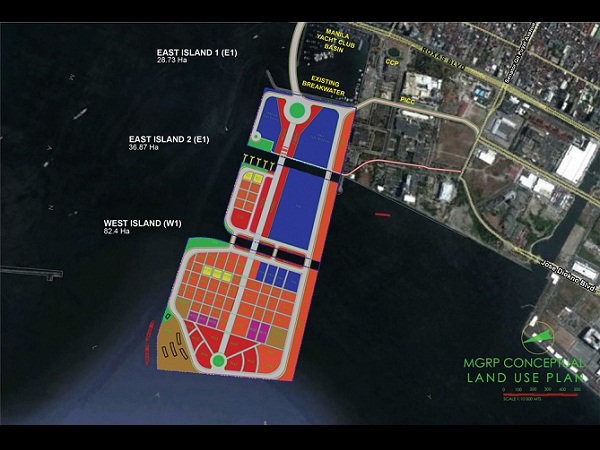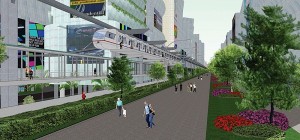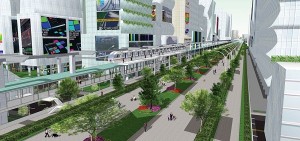Realty exec defends Manila Bay reclamation

RESHAPING THE COAST A map of the “Solar City’’ reclamation project as envisioned by Manila Goldcoast Development Corp. MGDC Photo
“Stop the disinformation.”
The head of the real estate firm behind a proposed multibillion-peso reclamation project on Manila Bay made this appeal, as he urged critics to “look at the bright side and accept the fact that it can be beneficial to the country if done properly and given the safety nets.”
“We strongly believe it is a viable development option for the city of Manila,” said William Tieng, chair and chief executive officer of Manila Goldcoast Development Corp., referring to the plan to turn a 148-hectare portion of the bay into a commercial, business, residential and tourism hub to be called “Solar City.”
Tieng, who is also the chair and chief executive officer of Solar Entertainment Corp., pointed critics to similar undertakings in Singapore, Hong Kong, The Netherlands, United Arab Emirates and China, where he said “they used land reclamation as a front door to urban development.”
In an exclusive interview with the Inquirer early this week, the Chinese-Filipino businessman stressed that “there’s nothing wrong with converting a small portion of the bay into one of the best places to live, work or do business in the Philippines, if not Southeast Asia.”
Article continues after this advertisementTieng defended the Manila Goldcoast Reclamation Project (MGRP) in response to groups who had warned that reshaping Manila Bay would have dire environmental repercussions and displace thousands of coastal folk who depend on the bay for their livelihood.
Article continues after this advertisementThese include the newly revived Coalition SOS: Save Manila Bay, which successfully campaigned against reclamation projects in the early ’90s; and the militant fisher folk group Pambansang Lakas ng Kilusang Pamamalakaya ng Pilipinas (Pamalakaya).
Coalition SOS members, who had initiated a petition to be given to the Manila city council, included Magsaysay Lines owner Doris Magsaysay Ho, Cultural Center of the Philippines president Emily Abrera, Worldwide Fund for Nature head Lory Tan, Ermita, Manila-based Catholic priest John Leydon, architect Paulo Alcazaren, and 1973 Miss Universe and environmentalist Margie Moran Floirendo, among others.
The group warned that the reclamation project would do more harm than good, citing geological studies showing that it could worsen flooding in Manila and put the bay area at the “highest risk of liquefaction in earthquake scenarios.” It also noted that the bay is a national historical landmark protected by law.
But Tieng said there is a need to “set the record straight.”
“Just like the CCP complex, which includes the Philippine International Convention Center, Folk Arts Theater, Manila Film Center, Coconut Palace (which now houses the Office of Vice President), and Sofitel Hotel, which by the way all stand on reclaimed land, the MGRP will not adversely affect the historic allure of the bay,” he said.
“With a frontage of only 635 meters parallel to Roxas Boulevard and occupying less than 0.082 percent of the bay’s surface area of 1,800 square kilometers, the project will not deprive Manila folk, as well as local and foreign tourists, of the view of the world-famous Manila Bay sunset,” he added.
The planned reclamation “will not touch the 1.5-kilometer stretch of Roxas Boulevard from the Manila Yacht Club to the US Embassy area.”
‘Green technology’
“Envisioned to abide by international best practices and standards of development projects and with the use of state-of-the-art green technology, the project will not adversely affect the marine environment. It will not cause any disruption of whatever nature to the bay’s marine ecology,” he said.
According to Tieng, “there’s no truth to claims that reclamation projects cause floods. In fact, they can reduce flooding like what they did in The Netherlands.
“We will have our own renewable power supply plus recycling and treatment of water and waste,” he said. The project “will not cause any displacement of settlers or lead to job losses” but, on the contrary, create jobs and raise revenues for both the national and city governments.
A 48-page master plan for the MGRP calls for the reclamation of three islands: East Island 1 (about 29 ha) which is the site closest to Manila Yacht Club; East Island 2 (37 ha); and West Island (82 ha). At least four bridges will connect East Island 2 and West Island.
Other project features include the construction of an international cruise ship terminal; Philippine Ports Authority berthing areas for ferries bound for Bataan, Cavite, Zambales and the Mindoro provinces, among other routes; controlled waterway system; an artificial beach; and medium- and high-rise residential condominium buildings.
City council lifts ban
As early as March 1991, the then Public Estates Authority (now Philippine Reclamation Authority) had given Elco Development & Construction Corp., Goldcoast’s parent company, the go-ahead to pursue the project as part of the Manila-Cavite Coastal Road Reclamation- North Sector Reclamation Project.
On March 31, 2011, the PRA board affirmed the “previous award of the MCCRR-North Sector Reclamation Project to Manila Goldcoast Development Corp.”
In an April 1, 2011, letter, PRA general manager Peter Anthony Abaya directed the firm to provide the agency with “updated development plans for the project to be prepared in coordination with the PRA in order to align the project with existing plans and programs of the PRA, particularly the Philippine Reclamation Plan.”
In April last year, the Manila city council passed an ordinance authorizing Mayor Alfredo Lim to apply for the reclamation, effectively repealing a 1992 ban on the project.
The city government also entered into an agreement with Goldcoast on the condition that the city be included in the consortium undertaking the project and will be given an equitable share in the reclaimed land.
The sharing scheme for the consortium will be 70.55 percent for Goldcoast and 29.45 percent for the city, according to the deal.
Goldcoast has applied for an environmental compliance certificate from the Department of Environment and Natural Resources, which is still processing the application.

